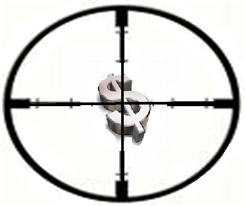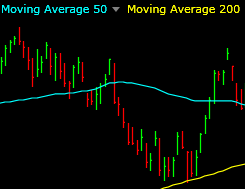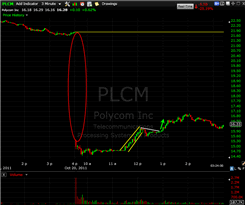Search Results for 'traders'
4 Traits of the Perfect Trader
 Maybe ‘perfect’ isn’t the right word. We can strive for it, but we’ll all fall short of it given enough time. Greatness, though…that’s attainable. But what does it take to become a great trader?
Maybe ‘perfect’ isn’t the right word. We can strive for it, but we’ll all fall short of it given enough time. Greatness, though…that’s attainable. But what does it take to become a great trader?
Well, I’m still working toward it myself, and maybe you are too, but we can agree it’s a combination of things. It’s having the ability to walk the line between two sometimes contradicting attitudes or beliefs. Here are a few of those, and I’d love to hear your thoughts on it if you have others to add to the list.
Great traders blend:
A ‘Just Go With It’ Attitude with a ‘Question Everything’ Mindset. What do I mean by that? Well, traders can be a skeptical bunch, but the best traders still act on what they see. A market move might be difficult to trust, but it’s underway and it’s happening with or without you. Traders know they can exit right away if it doesn’t work out, because after all, isn’t that why we trade rather than invest? I recently saw a comment regarding a “real bull market” by a self-proclaimed trader. I find it silly that a trader actually cares. Real traders don’t mind if the moves last or not, they just go with it and adapt along the way.
Flexibility with Structure. Great traders have a game plan in place, which gives them structure or a framework of rules to guide them in the right direction and help them avoid trouble. But they’re also very flexible in how they implement their game plan. They may not deviate from their discipline, but they can shift gears quickly when conditions call for a momentum-based tape or some fade trades when prices are range-bound.
Confidence with Respect for the Market. This is a tough one and in my experience, never completely mastered. Great traders understand risk, and they know the market can take their hard-won capital quickly if they don’t defer to the price action when their timing is off. However, they aren’t afraid to participate, so when they see what they like, they execute with confidence. This might be among the hardest things to get a grip on for a developing trader.
Science with Art. Trading is definitely a science to some (quants, that’s you!), and it’s an art form to others (tape readers, holla!). Some traders develop their own discretionary system whereby they know exactly what they’re looking for but weigh a number of factors before executing. That might mean taking into consideration if the market’s fast or slow, or if there’s a trend or indecision, or how a run ahead of scheduled news might prompt a reversal. Great traders develop a feel (art) through their experience, helping them identify better when to implement the proper strategy (science).
Where do you fit into the mix? Are you out of balance in one or more of these areas? What can you start improving on today?
Trade Like a Bandit!
Jeff White
Producer of The Bandit Broadcast
Follow TheStockBandit on Twitter or get our free newsletter to keep up!
Market Makers, Specialists, and Stops
A subscriber recently asked me:
“Do you believe market makers and specialists really gun for the orders that are on the books that are only a few hundred shares, or do they only search out bigger size?”
Here’s my response:
 My take on market makers and specialists is that they just want volume, all day, as they’re selling on the offer and buying on the bid. A few hundred shares here throughout the day add up to a lot. Stocks will naturally gravitate toward key areas of support and resistance, so if they just get close then it’s not that difficult for market makers to ‘spook’ prices a little further and run some stops.
My take on market makers and specialists is that they just want volume, all day, as they’re selling on the offer and buying on the bid. A few hundred shares here throughout the day add up to a lot. Stocks will naturally gravitate toward key areas of support and resistance, so if they just get close then it’s not that difficult for market makers to ‘spook’ prices a little further and run some stops.
Suppose there’s resistance just a few cents away, they know buy stops reside beyond that level. Flashing a big bid will have shorts quickly covering based upon the quote (which is real by the way), and buyers step in front of it in hopes of catching a run. They can then flip that large order to the ask and it spooks everyone to sell, taking the stock right back down to where it was.
You can see how doing that throughout the day adds to the back-and-forth range-bound type of price action which churns the accounts of retail traders and leaves the stock not necessarily making any big headway.
Also, do not discount the presence of programs doing this exact same thing. If supercomputers can automate the process via algo’s, all the better for the smart money to spook the retail traders out of positions on a regular basis. Head-fake moves which last only long enough to inflict enough pain to prompt an exit is all it takes, so it need not be a lasting move to catch the small trader off guard and separate him from a dime here or a quarter there.
One last thing…
On a trend day when market makers are shorting into strength (selling on the offer during an uptrend ), if they didn’t have a lot of inventory to dump, then they’re getting shorter the higher we go. They will hedge via futures (ES or NQ) or through options. Those derivatives have a huge impact on how the market moves, yet few traders really recognize that.
So when people watch call buying activity or put buying activity in the options, they think they know that someone big is betting on a rise or fall in the shares, but the fact is nobody knows if it’s that simple or if it’s part of a more complicated hedge for a market-neutral position.
It gets cloudy, but there’s my take on market makers and specialists. What’s your opinion?
Trade Like a Bandit!
Jeff White
Producer of The Bandit Broadcast
Follow TheStockBandit on Twitter or get our free newsletter to keep up!
How to Think About a Loss
 We all lose here and there, it’s just part of trading. You can’t avoid it, but that isn’t the issue. Where many traders struggle is how to handle a loss gracefully.
We all lose here and there, it’s just part of trading. You can’t avoid it, but that isn’t the issue. Where many traders struggle is how to handle a loss gracefully.
Instead if equating a trading loss with personal failure, shift your mentality for what a loss means.
Does it mean you’re stupid? Not necessarily.
Does it mean you were wrong? Yes, in at least one way.
Does that mean you will never get it back? Absolutely not.
Losses are an event, yes, but it’s also a distribution from your account. Consider them a cost of doing business as a trader. Brick-and-mortar stores have overhead, but as a trader, the biggest portion of your overhead is the losses you take.
When businesses cut costs, they’re reducing their overhead as much as possible to fatten their profit margins. Do the same with your trading. Reduce your ‘loss overhead’ by accepting a loss quickly and moving on to the next trade.
It’s much more fun to always be adding to your account rather than seeing funds flow out, but as soon as you start viewing trading losses as something impersonal, it’s going to change your perspective in a very helpful way. Rather than fret over them and allow losses to cloud your thinking or alter your mood, viewing them through the proper lens will help you more quickly get them back and then some.
Like it or not, trading is a business…how are you managing yours?
Trade Like a Bandit!
Jeff White
Producer of The Bandit Broadcast
Follow TheStockBandit on Twitter or get our free newsletter to keep up!
Questioning the 50-day & 200-day MA’s
 My recent post on Indicatoritis discussed how some traders rely on indicators incorrectly.
My recent post on Indicatoritis discussed how some traders rely on indicators incorrectly.
I believe that still holds true, but I was questioned about some common moving averages on the heels of that post.
So in this video, I want to discuss moving averages, and more specifically, two moving averages which are commonly accepted by traders as important: the 50-day and the 200-day moving averages.
We’ll look at some big-name stocks and let the charts speak for themselves on whether it’s appropriate or not to leave these MA’s on the chart all the time.
Be sure to view in HD (720P) and full-screen mode for best quality in the video.
Trade Like a Bandit!
Jeff White
Producer of The Bandit Broadcast
Follow TheStockBandit on Twitter or get our free newsletter to keep up!
Post-Earnings Day Trading Profits
 Earnings season brings with it a host of opportunities. It includes the potential for new leadership to emerge once it’s all said and done, but in the heat of it, the price action offers some excellent chances to participate in emotional short-term moves via day trades.
Earnings season brings with it a host of opportunities. It includes the potential for new leadership to emerge once it’s all said and done, but in the heat of it, the price action offers some excellent chances to participate in emotional short-term moves via day trades.
Traders expect big gaps during earnings season, and quite a few roll the dice ahead of it in hopes of receiving a market gift. Fortunately though, a trader need not participate in the gap itself to do well.
The post-earnings gap is a regular occurrence for most stocks, although some make a larger move than others. The outlier moves are the ones to watch closest, as they can signal either the beginning of a new move, or an overreaction with reversal potential.
Thursday’s move in PLCM was an example of the latter, as a 30% opening gap to the downside proved to be a bit much. The stock made a huge run higher intraday, although as I’ll show in the video, catching the entire run wasn’t necessary. Instead, grabbing pieces here and there can prove quite lucrative when there’s heavy volume and high emotion present.
In this video, I’ll share with you how I profited in the stock despite feeling like I missed both the big moves (the gap and most of the upside reversal). The fact is, when a stock is in play like PLCM was, there’s opportunity for several kinds of plays along the way. And the exciting part is that this happens nearly every day during earnings season, 4 times per year.
Be sure to watch full-screen on the 720p setting for the HD version of the video.
Trade Like a Bandit!
Jeff White
Producer of The Bandit Broadcast
Follow TheStockBandit on Twitter or get our free newsletter to keep up!
3 Ways to Overcome Your Fear from Past Trades
 Traders are a skittish bunch. We can make the same trade 100 times, but the one time a left-field event occurs, it can spook us forever.
Traders are a skittish bunch. We can make the same trade 100 times, but the one time a left-field event occurs, it can spook us forever.
The other night, I let the dog outside before bedtime. He’s a 7-year old Boston Terrier, so I’ve done that literally a couple thousand times. This time, however, he returned to the porch with an unusual look. I knew what happened before I even opened the door, because I could smell it…he’d been sprayed by a skunk.
An hour later after thoroughly bathing him outside, our house still reeked – despite not letting him in until he’d been bathed. And let me just say, fresh skunk spray smells nothing like roadkill skunk. It’s WAY worse.
Thankfully, the stench is long gone now, but that single event conditioned me, and I’m concerned now when I let him out every night…all because of that one awful experience! Doesn’t seem right, does it?
Spooked By The Past
In trading, we have to remind ourselves regularly to remain in the present tense. Because this setup burned you last time doesn’t mean it will this time. Maybe your first couple of trades of the day were losses, and now you’re scared to touch another trade. Or perhaps you’re coming off a tough few months and you’re afraid to get back in the mix.
While respect for the market and quality risk management are of utmost importance, what I’m referring to here is the crippling fear that’s costing you. It’s the fear that’s preventing you from elevating your performance, or from digging out of what should be a manageable hole. It’s the kind of fear that has you paralyzed and unable to pull the trigger on anything.
Return to Trading Confidently
Here are 3 Ways to Overcome Your Fear of the Past:
1. Understand your odds for success. This of course includes an honest risk assessment of the play, but it also means knowing whether this type of play is likely to work given the conditions. Going over your results consistently will reveal which kinds of plays are working in the current environment and which are more likely to fail. If you understand your odds for success and you’re able to have some mathematical confidence, it would be more costly to skip the trade.
2. Understand failure. Knowing the worst-case outcome if this trade happens to fail can reduce the fear inflicted by a previous failure from an unseen event. Black swan events aren’t common, so it’s not reasonable to fear them every time you approach a setup. Weigh the potential for loss, and if it’s outweighed by the potential for gain, the probabilities are favorable enough to participate.
3. Choose to move forward. All of us have the ability to choose, whether it’s our career or our spouse or our attitude. Maybe your fear somehow gives you comfort right now, because it’s been a habit you’ve allowed. That won’t cut it though, so it’s time to change. Eventually, you either decide to get back on the right path, or you’re completely done trading. Make your choice and get on with it – and don’t look back.
Don’t let the past haunt you into skipping potentially solid plays. Assess your risk, and then take the trade confident that over time, the numbers will work to your advantage.
Trade Like a Bandit!
Jeff White
Producer of The Bandit Broadcast
Follow TheStockBandit on Twitter or get our free newsletter to keep up!
Avoiding Indicatoritis
 Would-be traders all tend to focus on indicators. The sense, I suppose, is that if there’s just some magic indicator to be added to the chart, then trading becomes easy.
Would-be traders all tend to focus on indicators. The sense, I suppose, is that if there’s just some magic indicator to be added to the chart, then trading becomes easy.
They’re way off.
Personally, I don’t rely on indicators. I am price & volume based when making decisions on trades, and although I might occasionally glance at a moving average or something, I like to keep my charts clean and put my focus at the roots of all indicators – price and volume.
Does that make me better? Maybe.
Does it make me more decisive? Absolutely.
Back when I first went full-time as a trader (remember I already had over 2 years of part-time experience trading), there was a guy in our trading office who suffered from indicatoritis. His monitor was the most colorful thing in the office, but also the most confusing. It looked like a child had taken the entire spectrum of dry-erase markers and drawn all over his screens – a complete mess from which no sense (or cents) could be made.
This was a man grasping for some kind of a signal, but what he actually got was 50 different signals which contradicted each other. His search for clarity resulted in confusion.
That’s not a technician at work, it’s a futile (and wasted) attempt at adding an ounce of consistency to his results. He was looking in the wrong place.
A few years later, I saw a presentation by a guy (who still maintains a pretty large following in the technical analysis community) who “sees” his plays develop from charts with so many indicators that price itself is virtually obscured. Are you kidding? Suffice it to say, I think he derives zero value from those charts in terms of actual trade signals, but rather makes a really good living off confused traders seeking a magic bullet.
Indicators: Use Sparingly
Traders by and large rely too heavily on indicators, when it’s far better to use those indicators for confirmation. The price chart should tell you everything you need to know, but if you want some secondary assurance, then an indicator can provide that – so long as you’re using the right ones and at the right time.
Remember this when it comes to indicators: more does not equal better! Simple is ideal.
The hard part of trading is getting out of losing trades and staying in good trades. The hard part is not locating the magic bullet. Don’t waste your time expecting to find the secret to 99% profitability, because it isn’t out there.
A better use of your time and effort is to focus on improving your methods. Even better, improve your mentality, because that’s where the real game of trading is won or lost.
Trade Like a Bandit!
Jeff White
Producer of The Bandit Broadcast
Follow TheStockBandit on Twitter or get our free newsletter to keep up!





